Localization of Disconnection Faults in PV Installations Using the Multiple Frequencies Injection Method
Abstract
:1. Introduction
2. Electrical Characteristics and Failure of a PV System
2.1. Electrical Characteristics of a PV System
2.2. Failure of PV Systems
3. Proposed Method (Multiple Frequency Injection Method)
3.1. AC and DC Characteristics of Solar Cells
3.2. Disconnection Detecting Method Using Multiple Frequency Injection
3.3. Detection Method of the Disconnection Position in the PV System
4. Results of the Simulation and Experiments
4.1. Results of the Simulation
4.2. Result of the Experiments
5. Conclusions
Author Contributions
Funding
Institutional Review Board Statement
Informed Consent Statement
Data Availability Statement
Conflicts of Interest
References
- Pathway to Critical and Formidable Goal of Net-Zero Emissions by 2050 is Narrow but Brings Huge Benefits, According to IEA Special Report. Available online: https://www.iea.org/news/pathway-to-critical-and-formidable-goal-of-net-zero-emissions-by-2050-is-narrow-but-brings-huge-benefits (accessed on 8 September 2021).
- Understanding PV System Losses, Part 1: Nameplate, Mismatch, and LID Losses. Available online: https://www.aurorasolar.com/blog/understanding-pv-system-losses-part-1/ (accessed on 8 September 2021).
- Eltawil, M.A.; Zhao, Z. Grid-connected photovoltaic power systems: Technical and potential problems—A review. Renew. Sustain. Energy Rev. 2010, 14, 112–129. [Google Scholar] [CrossRef]
- Ropp, M.E.; Begovic, M.; Rohatgi, A. Prevention of islanding in grid-connected photovoltaic systems. Prog. Photovolt. Res. Appl. 1999, 7, 39–59. [Google Scholar] [CrossRef]
- Connecting Solar Panels Together. Available online: https://www.alternative-energy-tutorials.com/solar-power/connecting-solar-panels-together.html (accessed on 8 September 2021).
- Pendem, S.R.; Mikkili, S. Performance evaluation of series, series-parallel and honey-comb PV array configurations under partial shading conditions. In Proceedings of the 2017 7th International Conference on Power Systems (ICPS), Shivajinagar, India, 21–23 December 2017; pp. 749–754. [Google Scholar] [CrossRef]
- Mehiri, A.; Hamid, A.; Almazrouei, S. The Effect of Shading with Different PV Array Configurations on the Grid-Connected PV System. In Proceedings of the 2017 International Renewable and Sustainable Energy Conference (IRSEC), Tangier, Morocco, 4–7 December 2017; pp. 1–6. [Google Scholar] [CrossRef]
- Hashunao, S.; Mehta, R.K. Fault Analysis of Solar Photovoltaic System. In Proceedings of the 2020 5th International Conference on Renewable Energies for Developing Countries (REDEC), Marrakech, Morocco, 24–26 March 2020; pp. 1–6. [Google Scholar] [CrossRef]
- Zhao, Y.; de Palma, J.; Mosesian, J.; Lyons, R.; Lehman, B. Line–Line Fault Analysis and Protection Challenges in Solar Photovoltaic Arrays. IEEE Trans. Ind. Electron. 2013, 60, 3784–3795. [Google Scholar] [CrossRef]
- Saleh, M.U.; Deline, C.; Kingston, S.; Jayakumar, N.K.T.; Benoit, E.; Harley, J.B.; Furse, C.; Scarpulla, M. Detection and Localization of Disconnections in PV Strings Using Spread-Spectrum Time-Domain Reflectometry. IEEE J. Photovolt. 2020, 10, 236–242. [Google Scholar] [CrossRef]
- Roman, E.; Alonso, R.; Ibanez, P.; Elorduizapatarietxe, S.; Goitia, D. Intelligent PV Module for Grid-Connected PV Systems. IEEE Trans. Ind. Electron. 2006, 53, 1066–1073. [Google Scholar] [CrossRef]
- Tsanakas, J.A.; Ha, L.; Buerhop, C. Faults and infrared thermographic diagnosis in operating c-Si photovoltaic modules: Areviewof research and future challenges. Renew. Sustain. Energy Rev. 2016, 62, 695–709. [Google Scholar] [CrossRef]
- Mellit, A.; Tina, G.M.; Kalogirou, S.A. Fault detection and diagnosis methods for photovoltaic systems: A review. Renew. Sustain. Energy Rev. 2018, 91, 1–17. [Google Scholar] [CrossRef]
- Quater, P.B.; Grimaccia, F.; Leva, S.; Mussetta, M.; Aghaei, M. Light Unmanned Aerial Vehicles (UAVs) for Cooperative Inspection of PV Plants. IEEE J. Photovolt. 2014, 4, 1107–1113. [Google Scholar] [CrossRef] [Green Version]
- Triki-Lahiani, A.; Abdelghani, A.B.-B.; Slama-Belkhodja, I. Fault detection and monitoring systems for photovoltaic installations: A review. Renew. Sustain. Energy Rev. 2018, 82, 2680–2692. [Google Scholar] [CrossRef]
- Furse, C.; Chung, Y.C.; Lo, C.; Pendayala, P. A critical comparison of reflectometry methods for location of wiring faults. Smart Struct. Syst. 2006, 2, 25–46. [Google Scholar] [CrossRef] [Green Version]
- Takashima, T.; Yamaguchi, J.; Otani, K.; Oozeki, T.; Kato, K.; Ishida, M. Experimental studies of fault location in PV module strings. Sol. Energy Mater. Sol. Cells 2009, 93, 1079–1082. [Google Scholar] [CrossRef]
- Zhang, J.; Zhang, Y.; Guan, Y. Analysis of time-domain reflectometry combined with wavelet transform for fault detection in aircraft shielded cables. IEEE Sens. J. 2016, 16, 4579–4586. [Google Scholar] [CrossRef]
- Kumar, R.A.; Suresh, M.S.; Nagaraju, J. Silicon (BSFR) solar cell AC parameters at different temperatures. Sol. Energy Mater. Sol. Cells 2005, 85, 397–406. [Google Scholar] [CrossRef]
- El-Maksood, A.M.A. Performance Dependence of (I-V) and (C-V) for Solar Cells on Environmental Conditions. J. Adv. Phys. 2018, 14, 5331–5351. [Google Scholar] [CrossRef]
- Harper, J.; Wang, X.I. CV and AC Impedance Techniques and Characterizations of Photovoltaic Cells. Available online: https://file.scirp.org/pdf/22-1.476.pdf (accessed on 9 September 2021).
- Kumar, S.; Sareen, V.; Batra, N.; Singh, P.K. Study of C–V characteristics in thin n+-p-p+ silicon solar cell sand induced junction n-p-p+ cell structures. Sol. Energy Mater. Sol. Cells 2010, 94, 1469–1472. [Google Scholar] [CrossRef]
- Kumar, S.; Singh, P.K.; Chilana, G.S. Study of silicon solar cell at different intensities of illumination and wavelengths using impedance spectroscopy. Sol. Energy Mater. Sol. Cells 2009, 93, 1881–1884. [Google Scholar] [CrossRef]
- Burgelman, M.; Nollet, P. Admittance spectroscopy of thin film solar cells. Solid State Ion. 2005, 176, 2171–2175. [Google Scholar] [CrossRef]
- Bayhan, H.; Kavasoˇglu, A.S. Admittance and Impedance Spectroscopy on Cu(In,Ga)Se2 Solar Cells. Turk. J. Phys. 2003, 27, 529–535. [Google Scholar]
- Kumar, R.A.; Suresh, M.S.; Nagaraju, J. GaAs/Ge solar cell AC parameters under illumination. Sol. Energy 2004, 76, 417–421. [Google Scholar] [CrossRef]
- Panigrahi, J.; Singh, R.; Batra, N.; Gope, J.; Sharma, M.; Pathi, P.; Srivastava, S.K.; Rauthan, C.M.S.; Singh, P.K. Impedance spectroscopy of crystalline silicon solar cell: Observation of negative capacitance. Sol. Energy 2016, 136, 412–420. [Google Scholar] [CrossRef]
- Mandal, H.; Nagaraju, J. GaAs/Ge and silicon solar cell capacitance measurement using triangular wave method. Sol. Energy Mater. Sol. Cells 2007, 91, 696–700. [Google Scholar] [CrossRef]
- Anantha Krishna, H.; Misra, N.K.; Suresh, M.S. Use of solar cells for measuring temperature of solar cell blanket in spacecrafts. Sol. Energy Mater. Sol. Cells 2012, 102, 184–188. [Google Scholar] [CrossRef]
- Principles of Communication—FM Radio. Available online: https://www.tutorialspoint.com/principles_of_communication/principles_of_communication_fm_radio.htm (accessed on 9 September 2021).
- Zhao, Y. Fault Analysis in Solar Photovoltaic Arrays. Ph.D. Thesis, Northeastern University, Boston, MA, USA, 2011. [Google Scholar]
- Trejos-Grisales, L.A.; Bastidas-Rodríguez, J.D.; Ramos-Paja, C.A. Mathematical Model for Regular and Irregular PV Arrays with Improved Calculation Speed. Sustainability 2020, 12, 10684. [Google Scholar] [CrossRef]
- Lillo-Bravo, I.; González-Martínez, P.; Larrañeta, M.; Guasumba-Codena, J. Impact of Energy Losses Due to Failures on Photovoltaic Plant Energy Balance. Energies 2018, 11, 363. [Google Scholar] [CrossRef] [Green Version]
- Cotfas, P.A.; Cotfas, D.T.; Borza, P.N.; Sera, D.; Teodorescu, R. Solar Cell Capacitance Determination Based on an RLC Resonant Circuit. Energies 2018, 11, 672. [Google Scholar] [CrossRef] [Green Version]
- Cotfas, D.T.; Cotfas, P.A.; Kaplanis, S. Methods and techniques to determine the dynamic parameters of solar cells: Review. Renew. Sustain. Energy Rev. 2016, 61, 213–221. [Google Scholar] [CrossRef]
- Yadav, P.; Pandey, K.; Bhatt, V.; Kumar, M.; Kim, J. Critical aspects of impedance spectroscopy in silicon solar cell characterization: A review. Renew. Sustain. Energy Rev. 2017, 76, 1562–1578. [Google Scholar] [CrossRef]
- Raj, S.; Kumar, S.A.; Panchal, A.K. Solar cell parameters estimation from illuminated I-V characteristic using linear slope equations and Newton-Raphson technique. J. Renew. Sustain. Energy 2013, 5, 255–265. [Google Scholar] [CrossRef]
- Cubas, J.; Pindado, S.; De Manuel, C. Explicit Expressions for Solar Panel Equivalent Circuit Parameters Based on Analytical Formulation and the Lambert W-Function. Energies 2014, 7, 4098–4115. [Google Scholar] [CrossRef] [Green Version]
- Mughal, M.A.; Ma, Q.; Xiao, C. Photovoltaic Cell Parameter Estimation Using Hybrid Particle Swarm Optimization and Simulated Annealing. Energies 2017, 10, 1213. [Google Scholar] [CrossRef] [Green Version]
- Ye, M.; Wang, X.; Xu, Y. Parameter extraction of solar cells using particle swarm optimization. J. Appl. Phys. 2009, 105, 094502. [Google Scholar] [CrossRef]
- Zagrouba, M.; Sellami, A.; Bouaïcha, M.; Ksouri, M. Identification of PV solar cells and modules parameters using the genetic algorithms: Application to maximum power extraction. Sol. Energy 2010, 84, 860–866. [Google Scholar] [CrossRef]
- Hasanien, H.M. Shuffled Frog Leaping Algorithm for Photovoltaic Model Identification. IEEE Trans. Sustain. Energy 2015, 6, 509–515. [Google Scholar] [CrossRef]
- Yu, K.; Chen, X.; Wang, X.; Wang, Z. Parameters identification of photovoltaic models using self-adaptive teaching-learning-based optimization. Energy Convers. Manag. 2017, 145, 233–246. [Google Scholar] [CrossRef]
- Stošović, M.A.; Lukač, D.; Litovski, I.; Litovski, V. Frequency domain characterization of a solar cell. In Proceedings of the 11th Symposium on Neural Network Applications in Electrical Engineering, Belgrade, Serbia, 20–22 September 2012; pp. 259–264. [Google Scholar] [CrossRef]
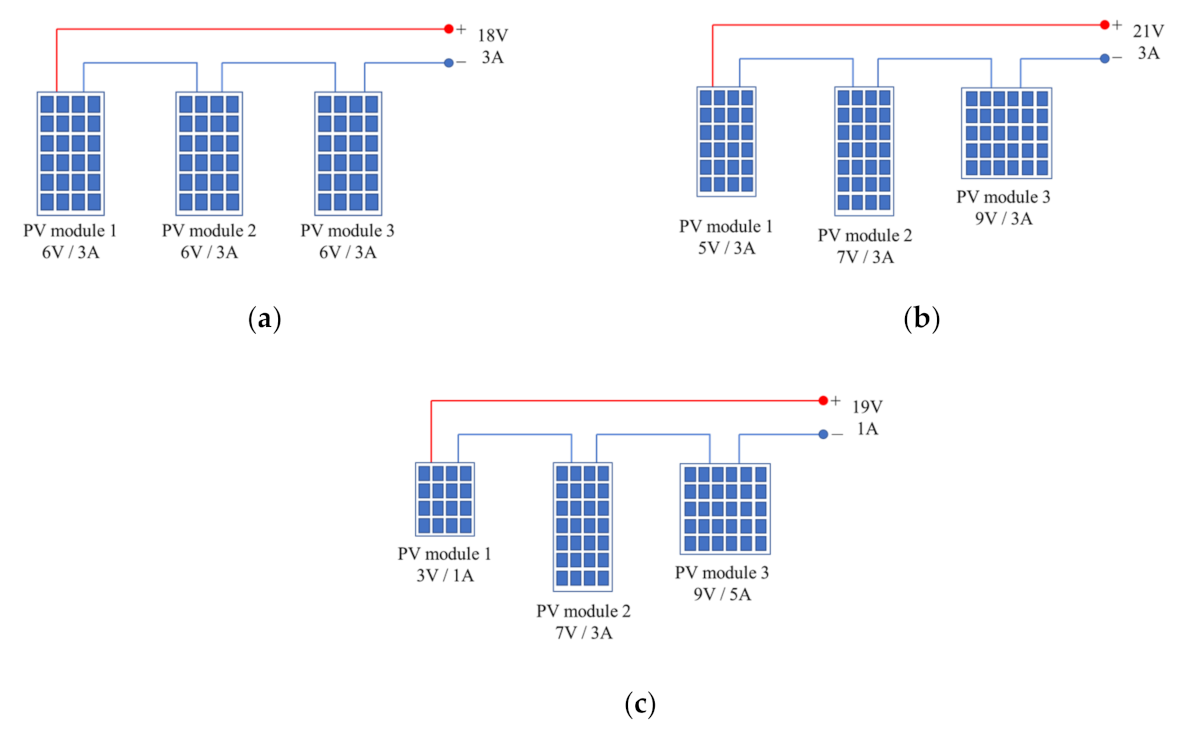
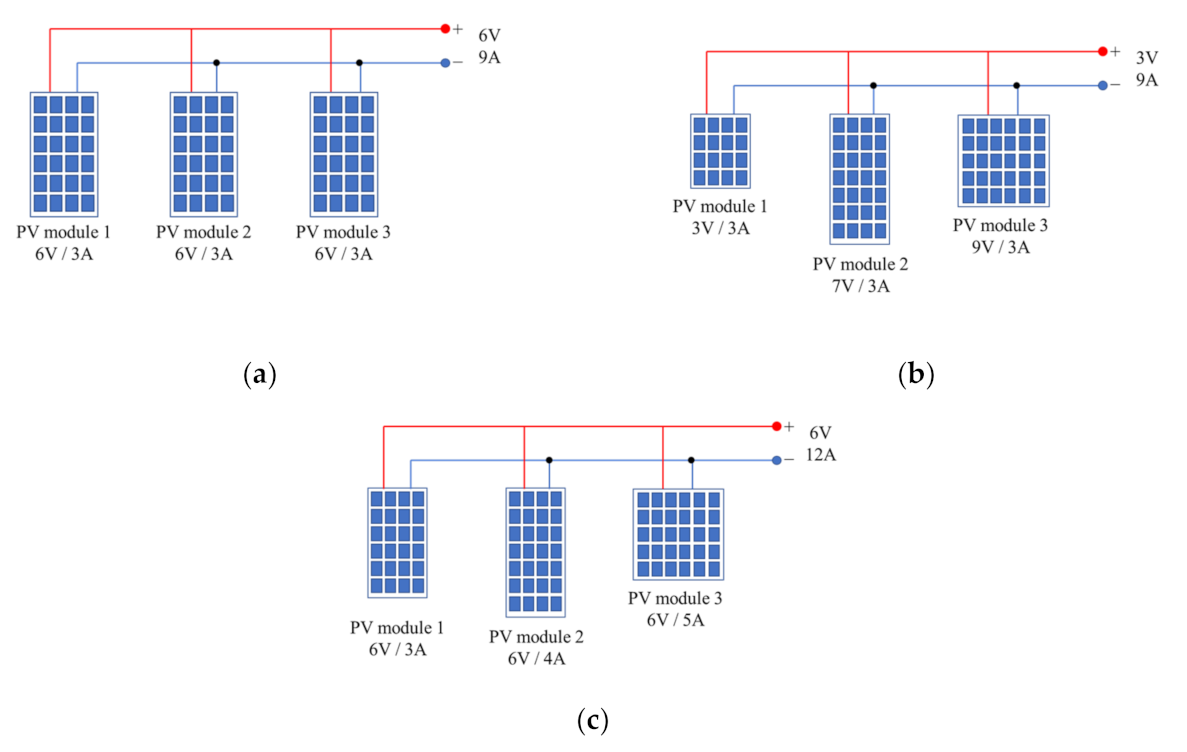

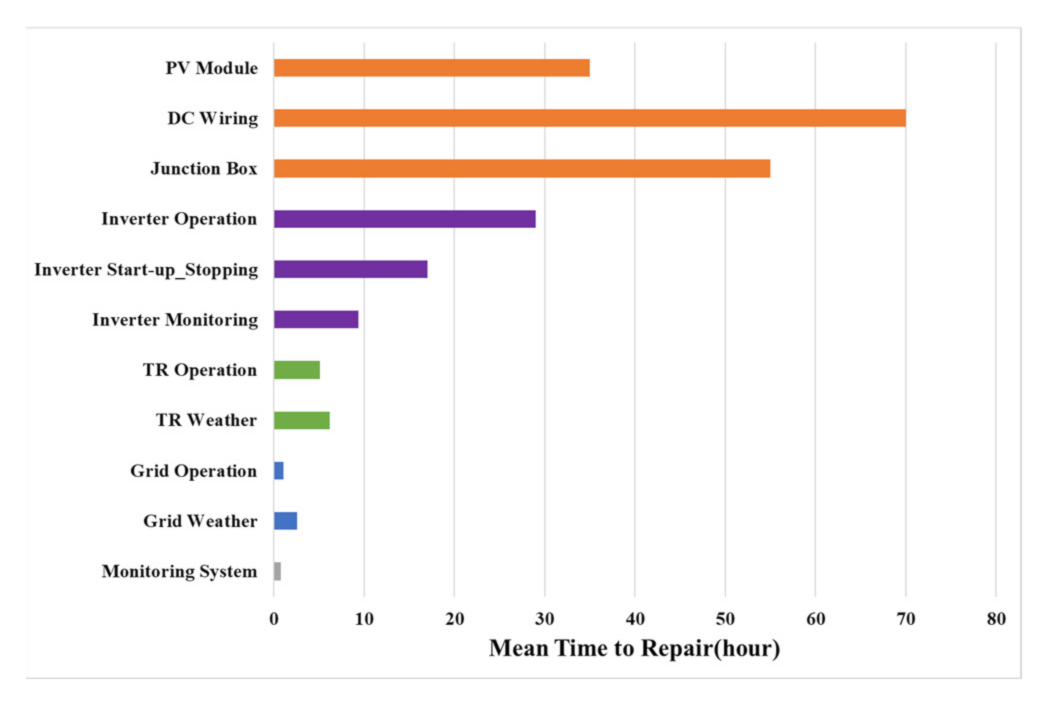

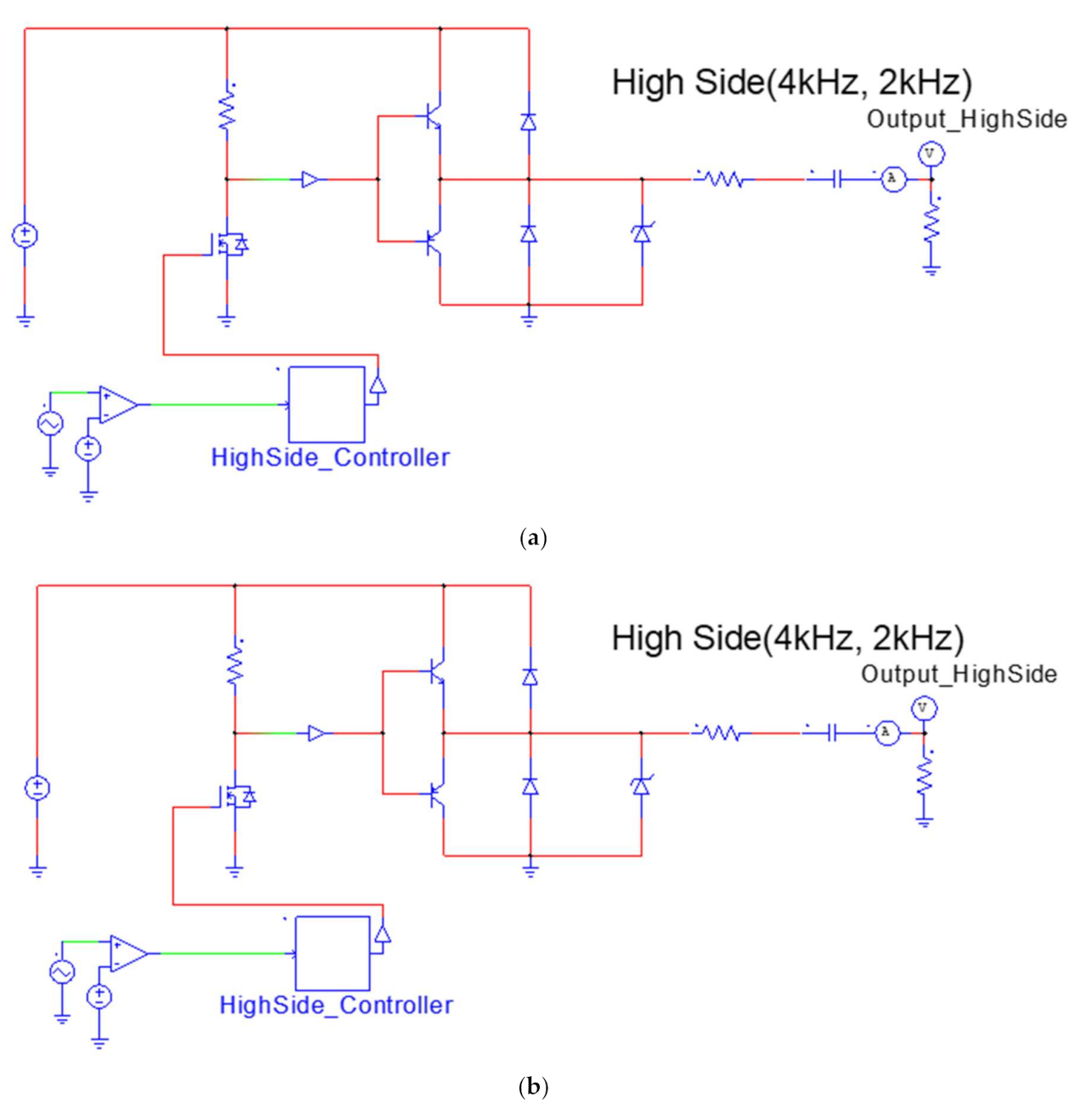
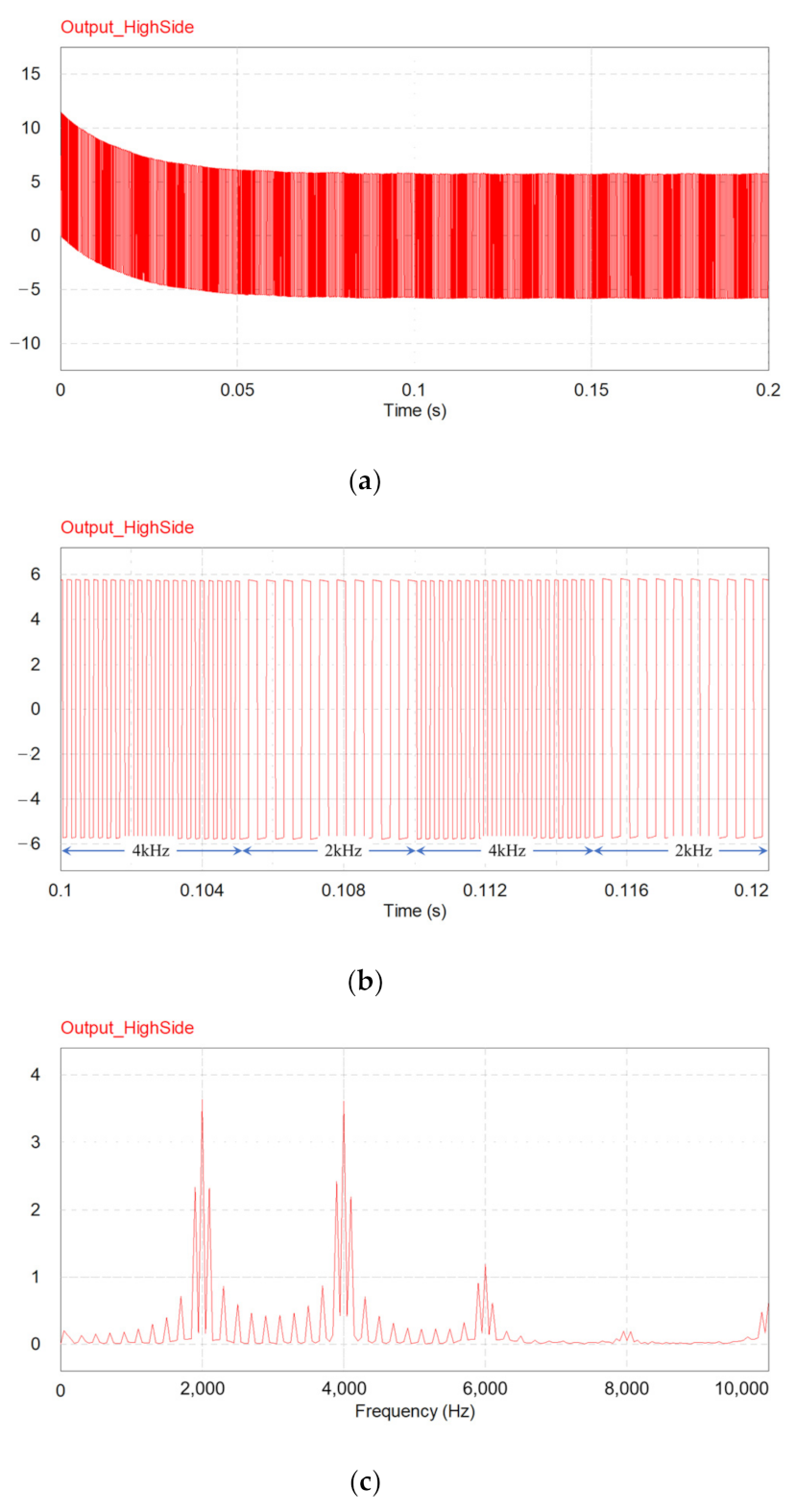
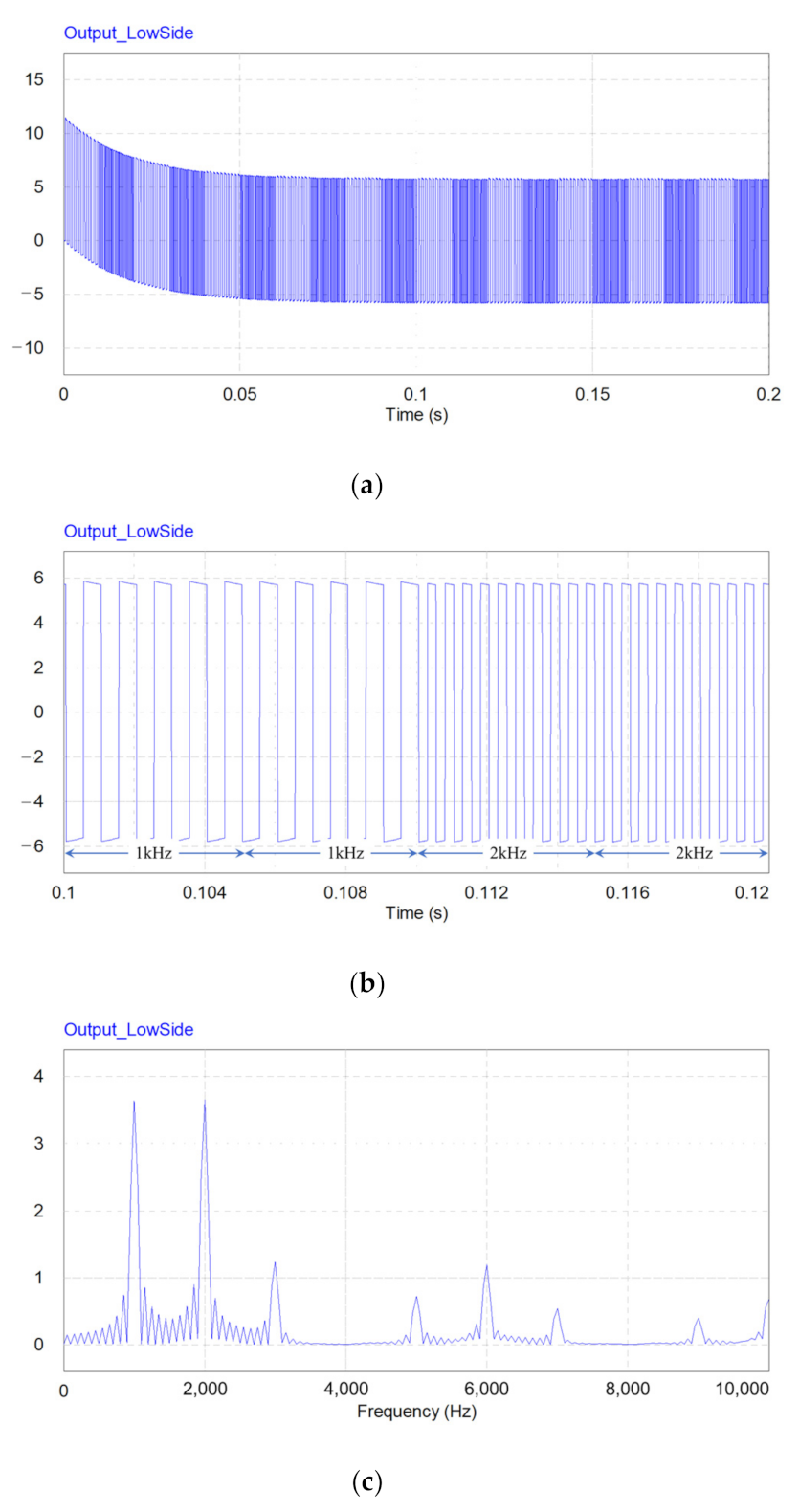

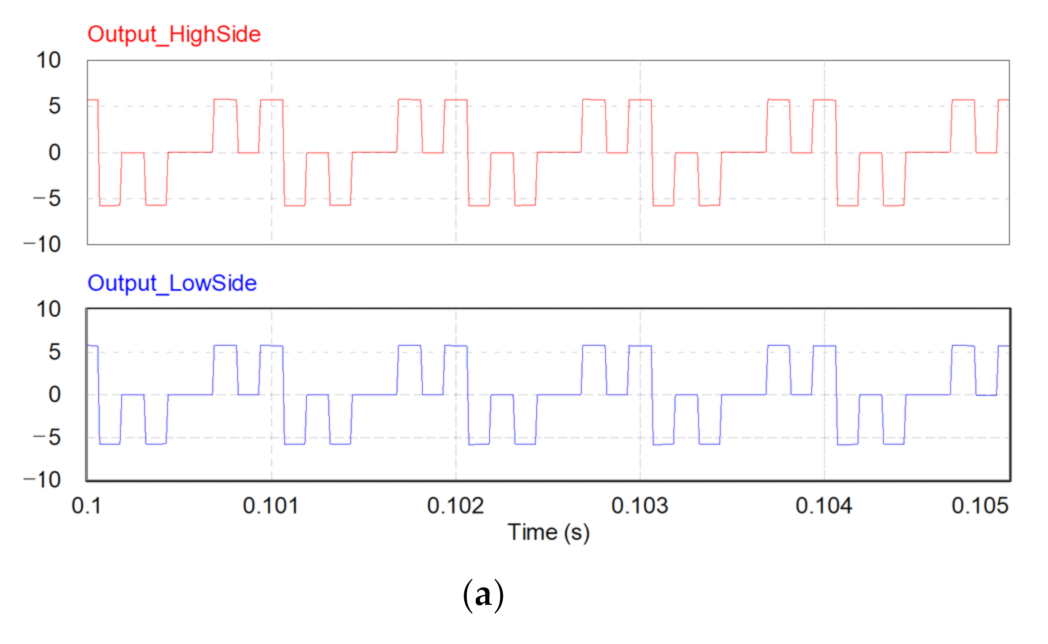

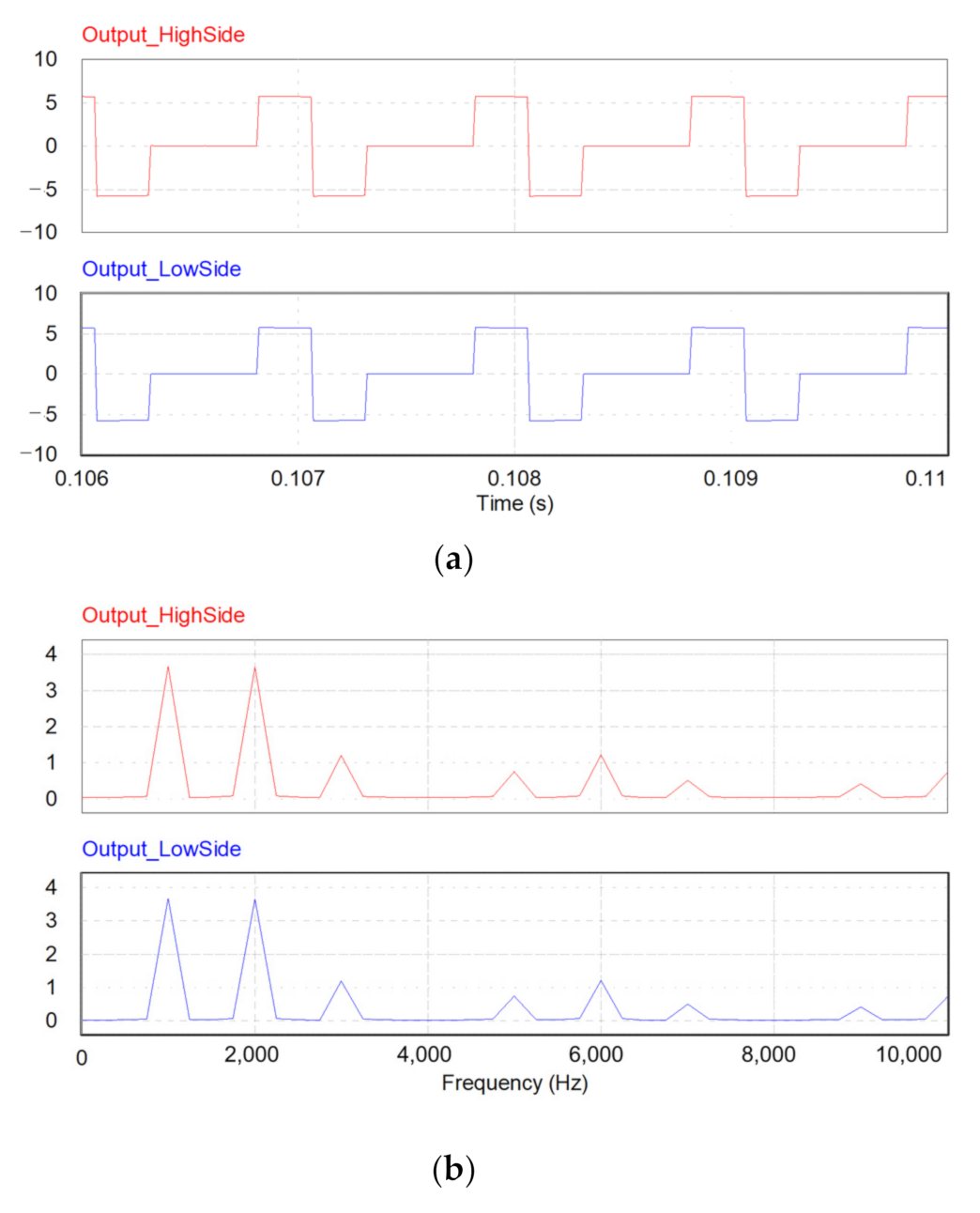


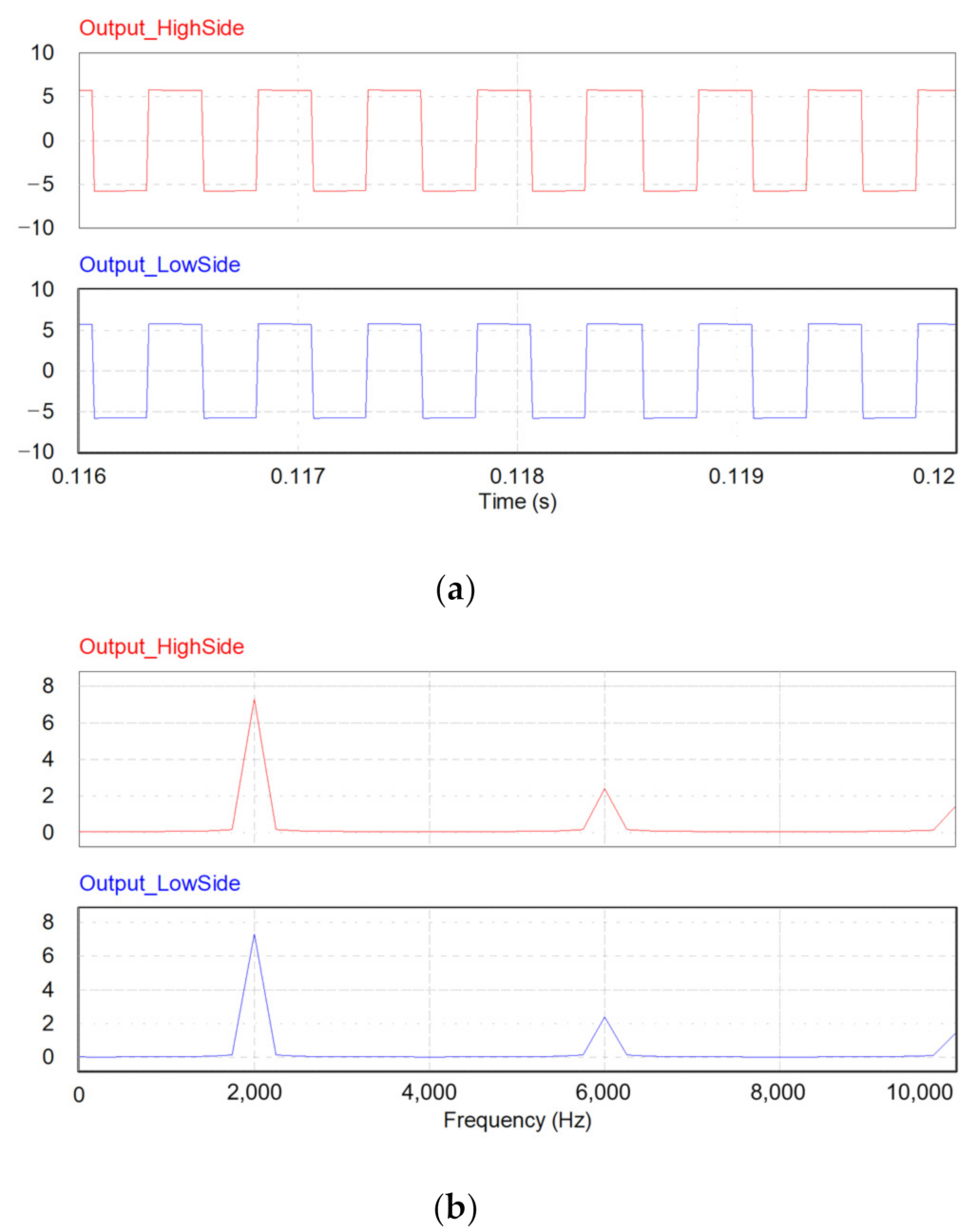
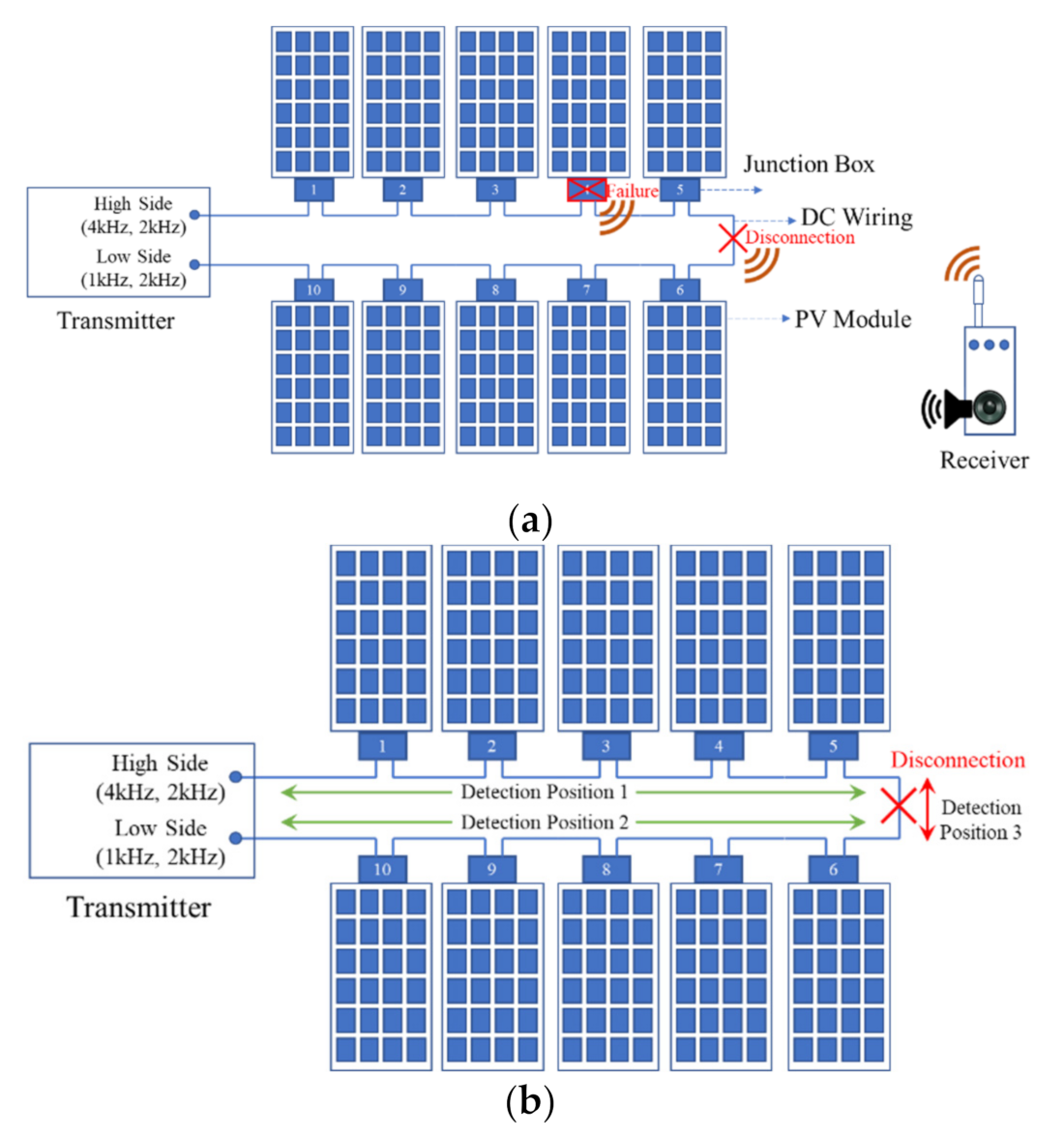
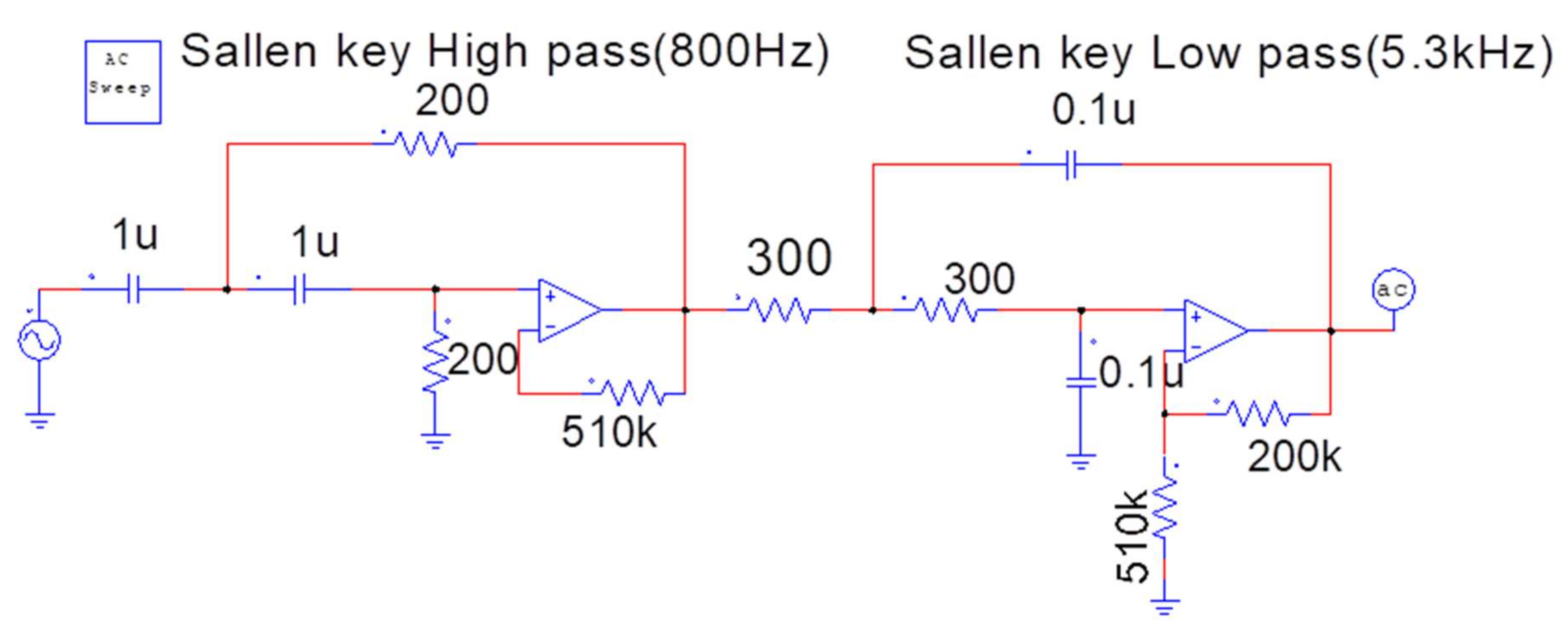
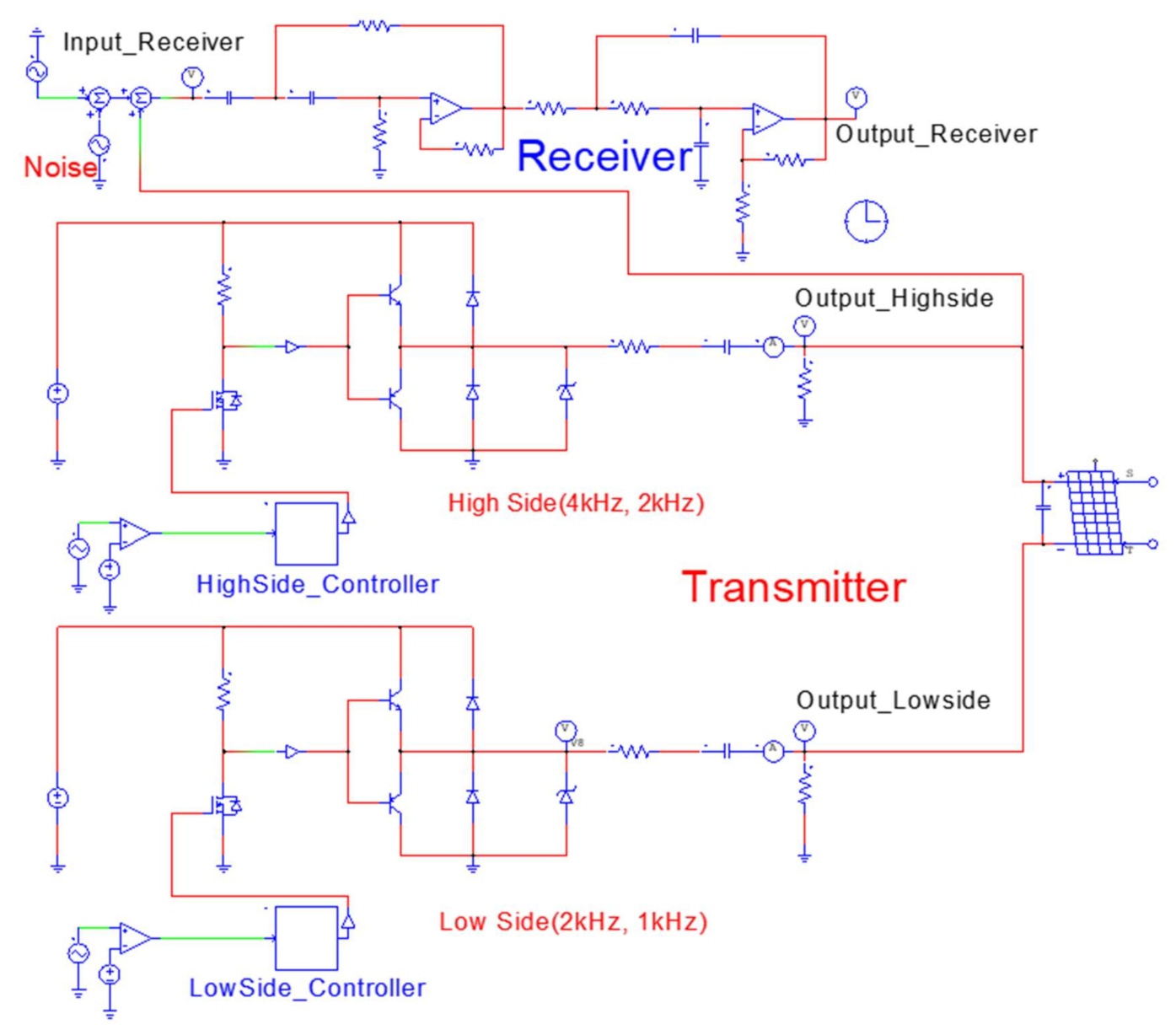
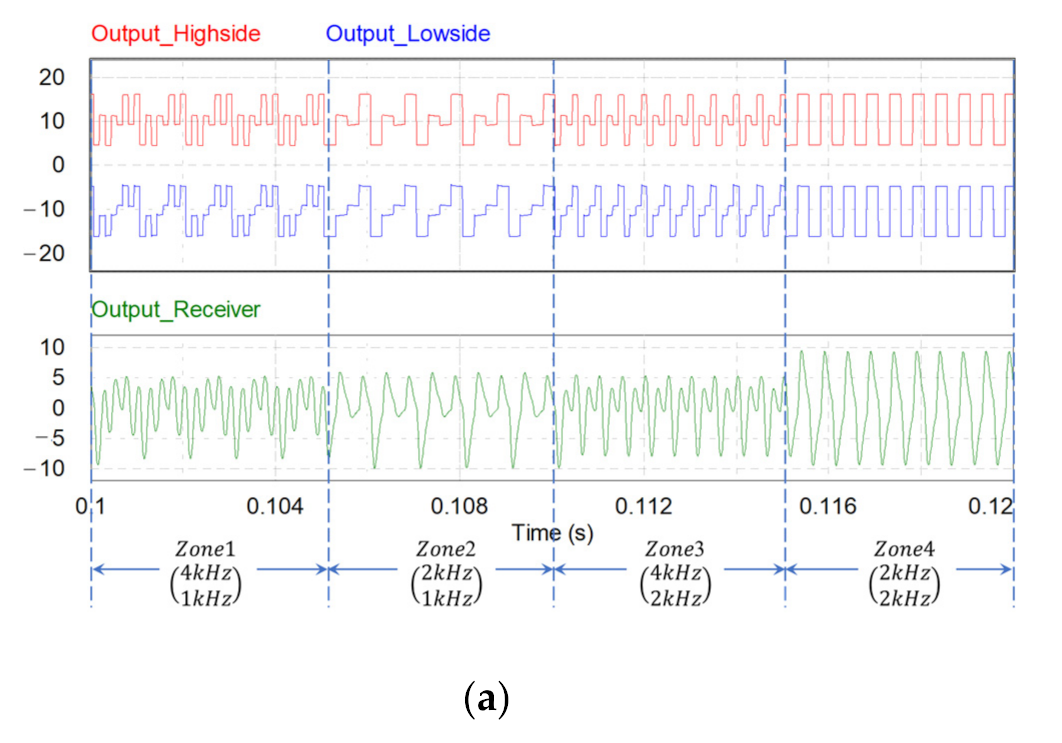
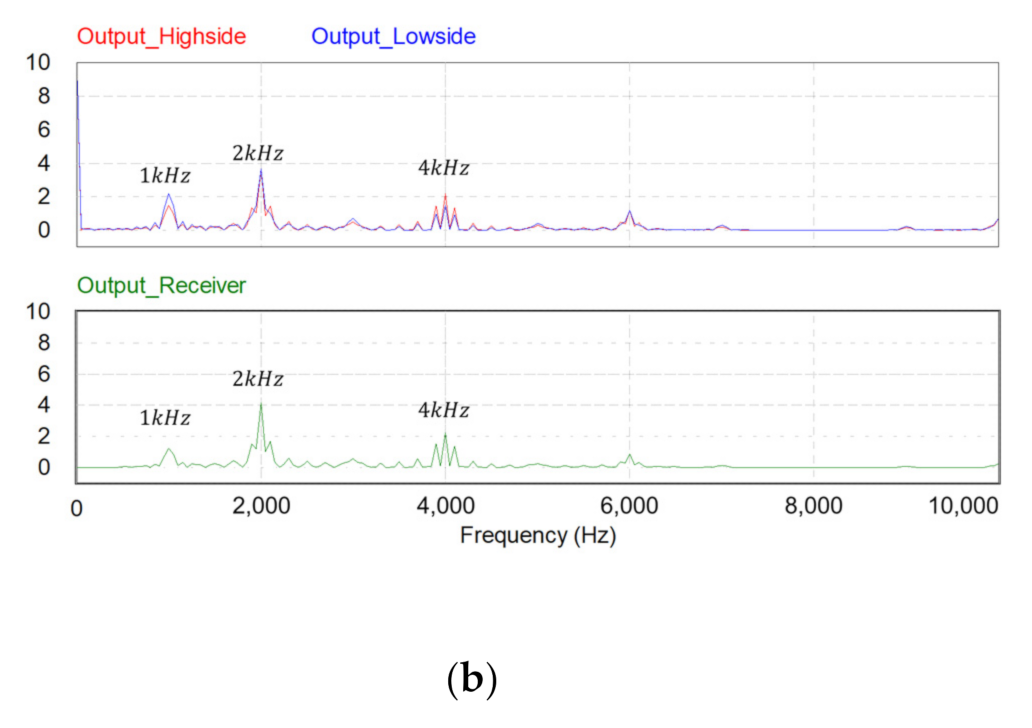
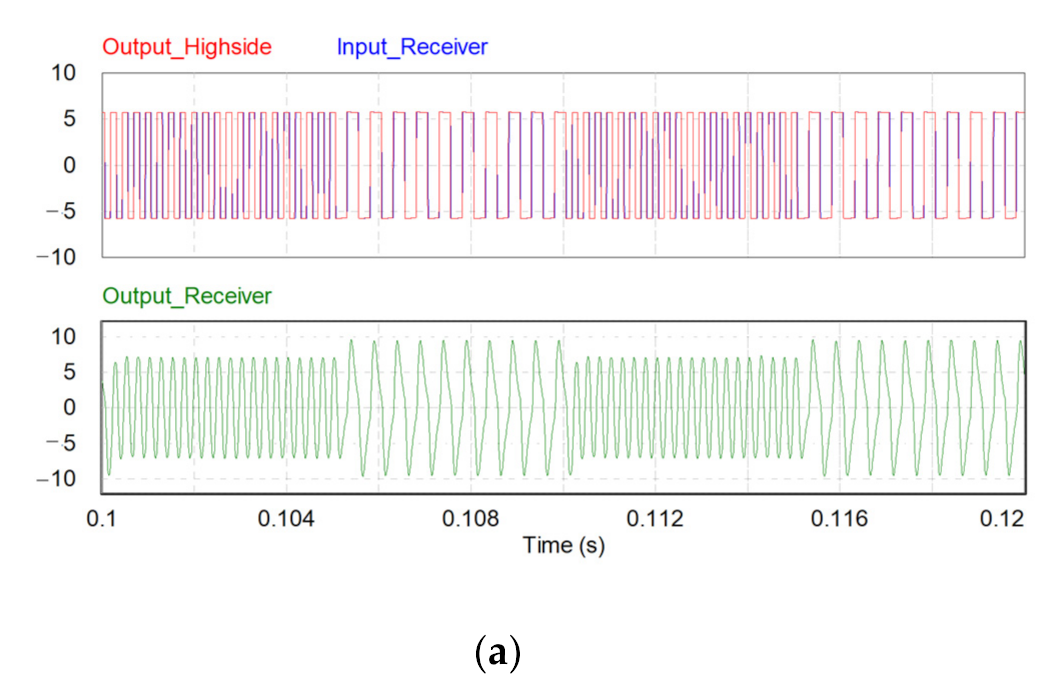

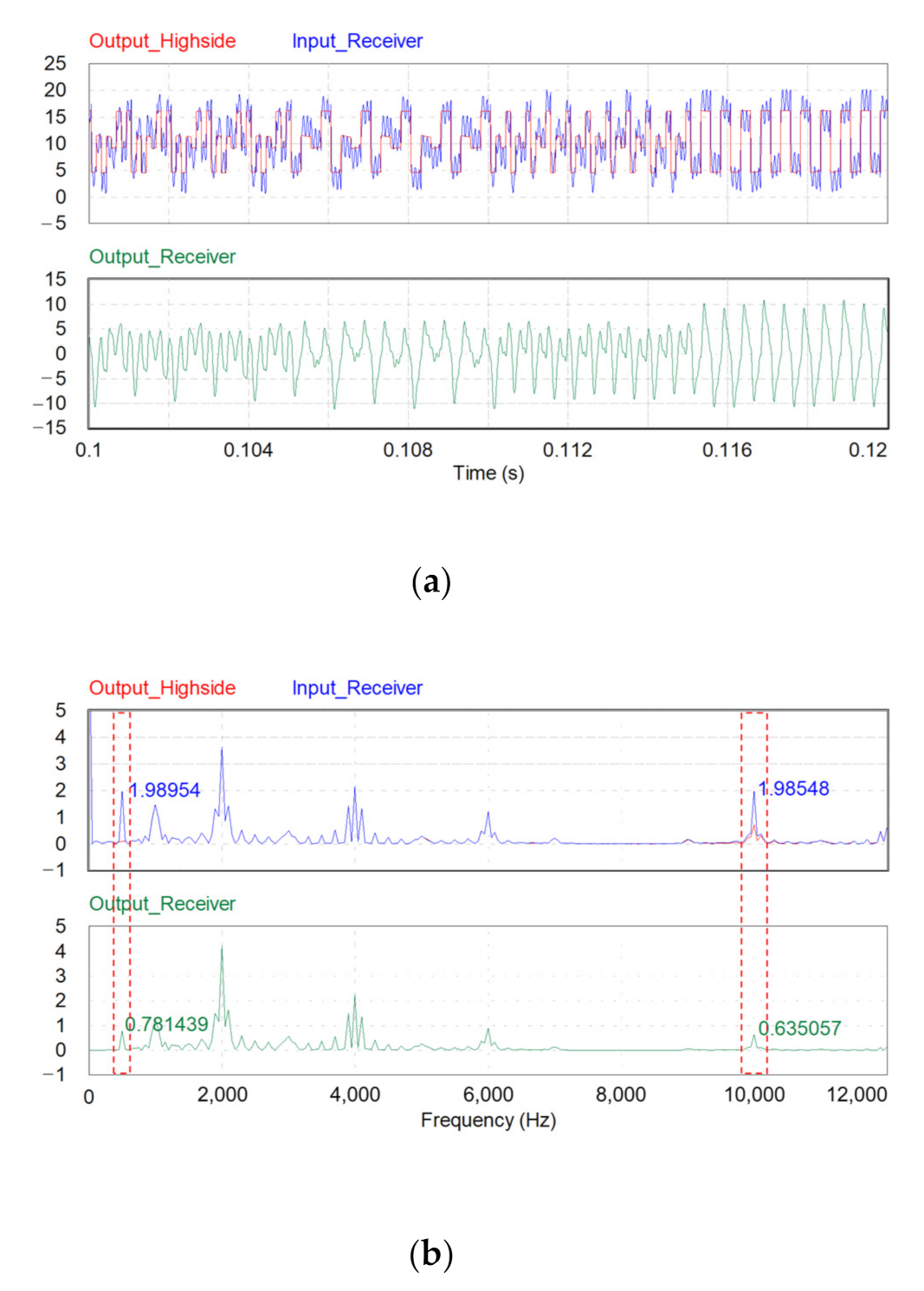


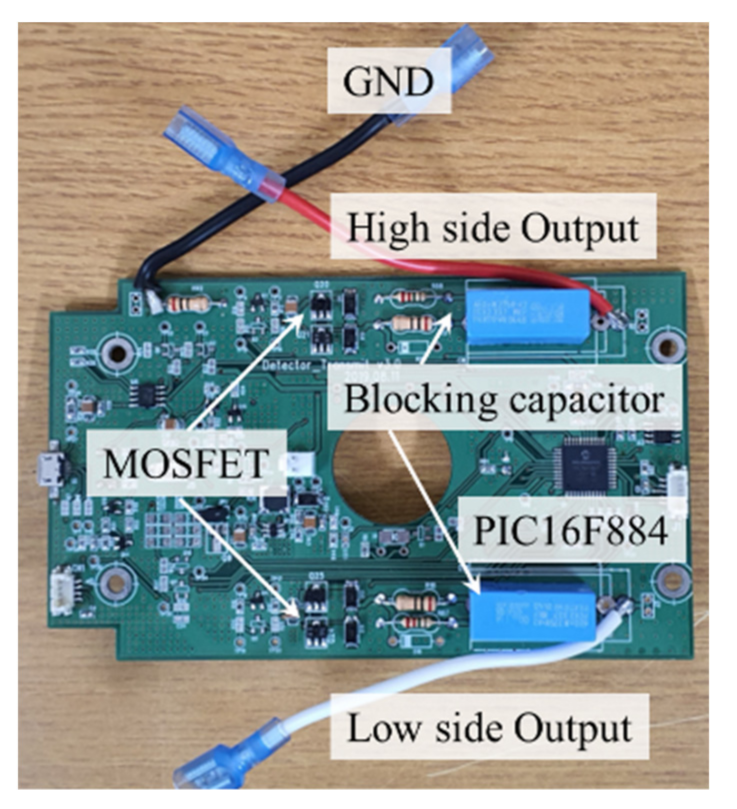
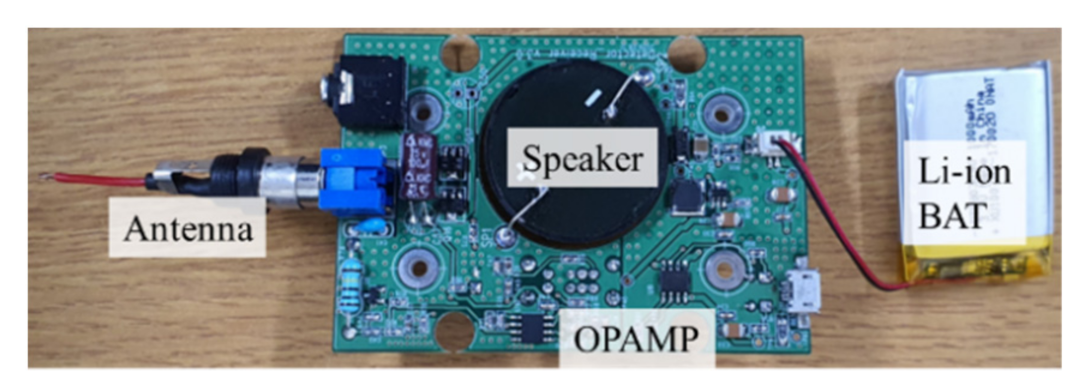
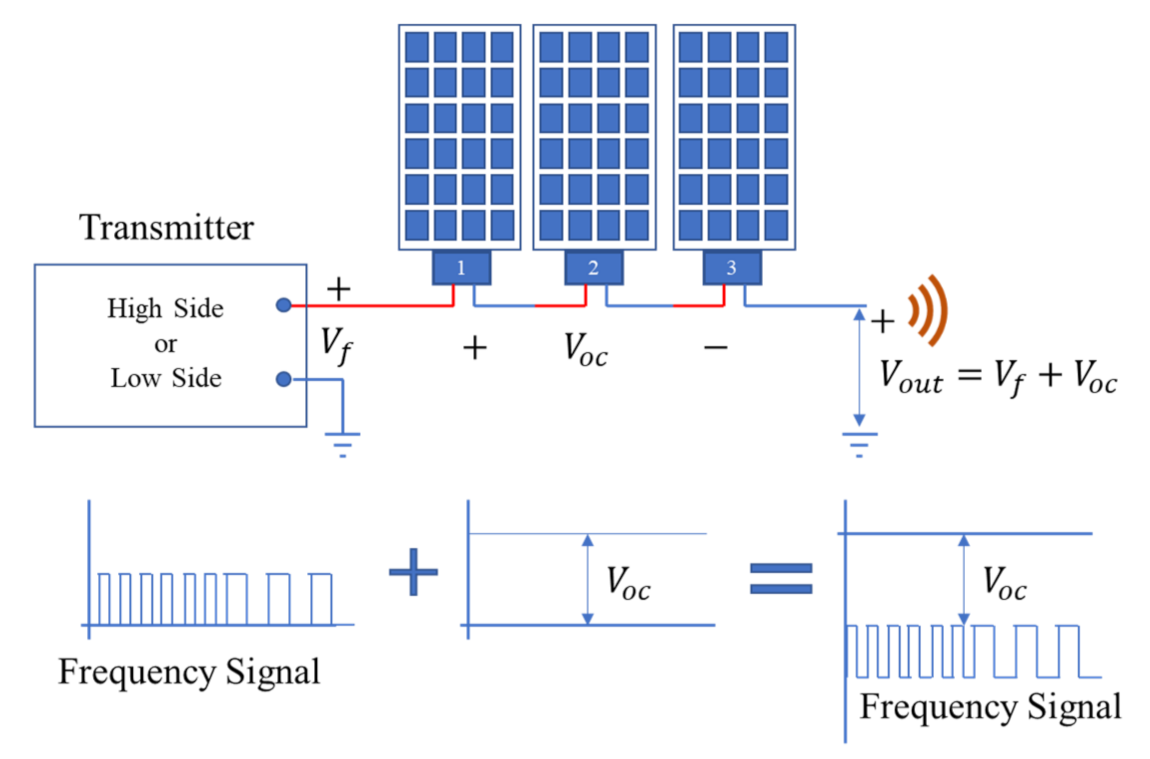




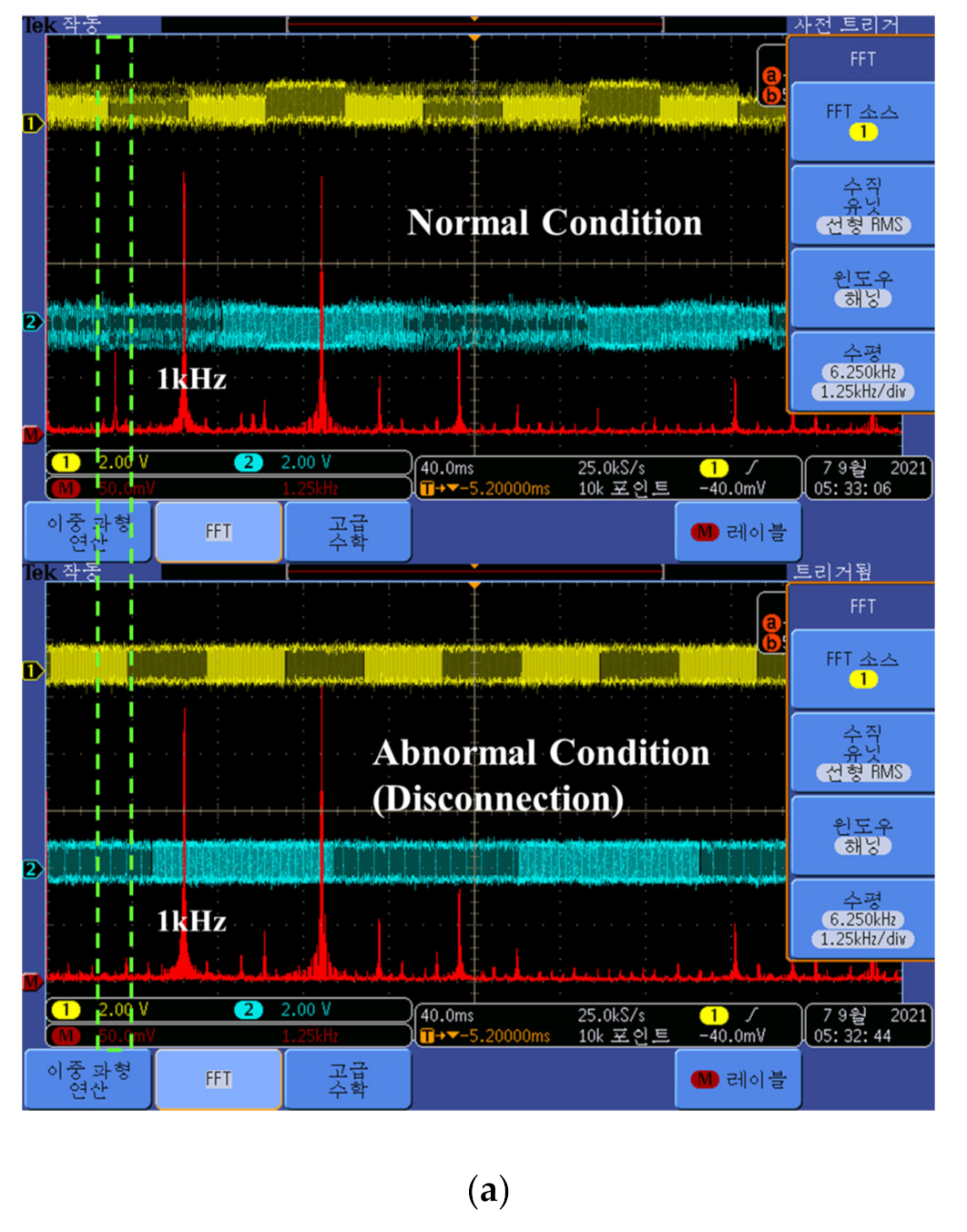
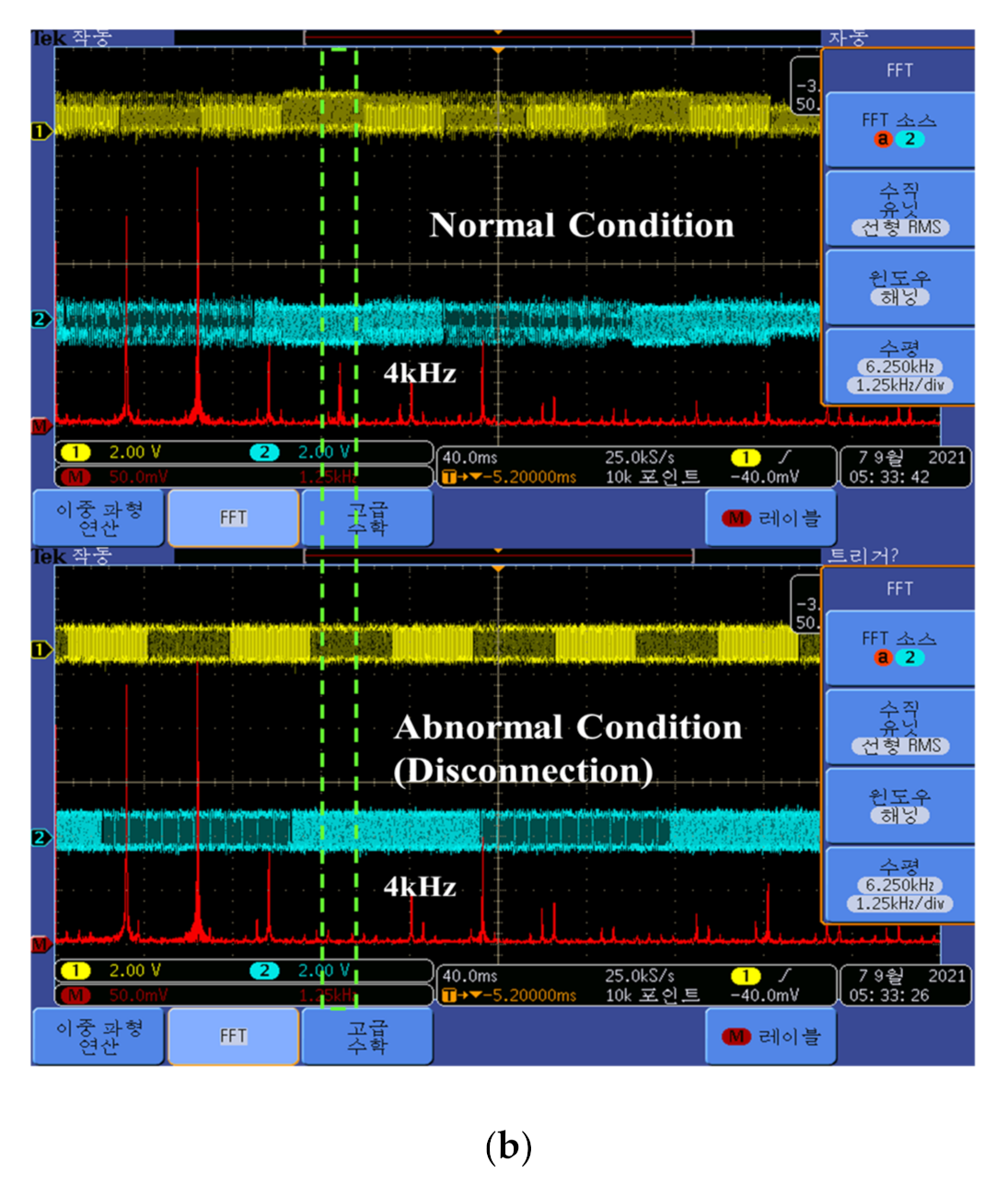
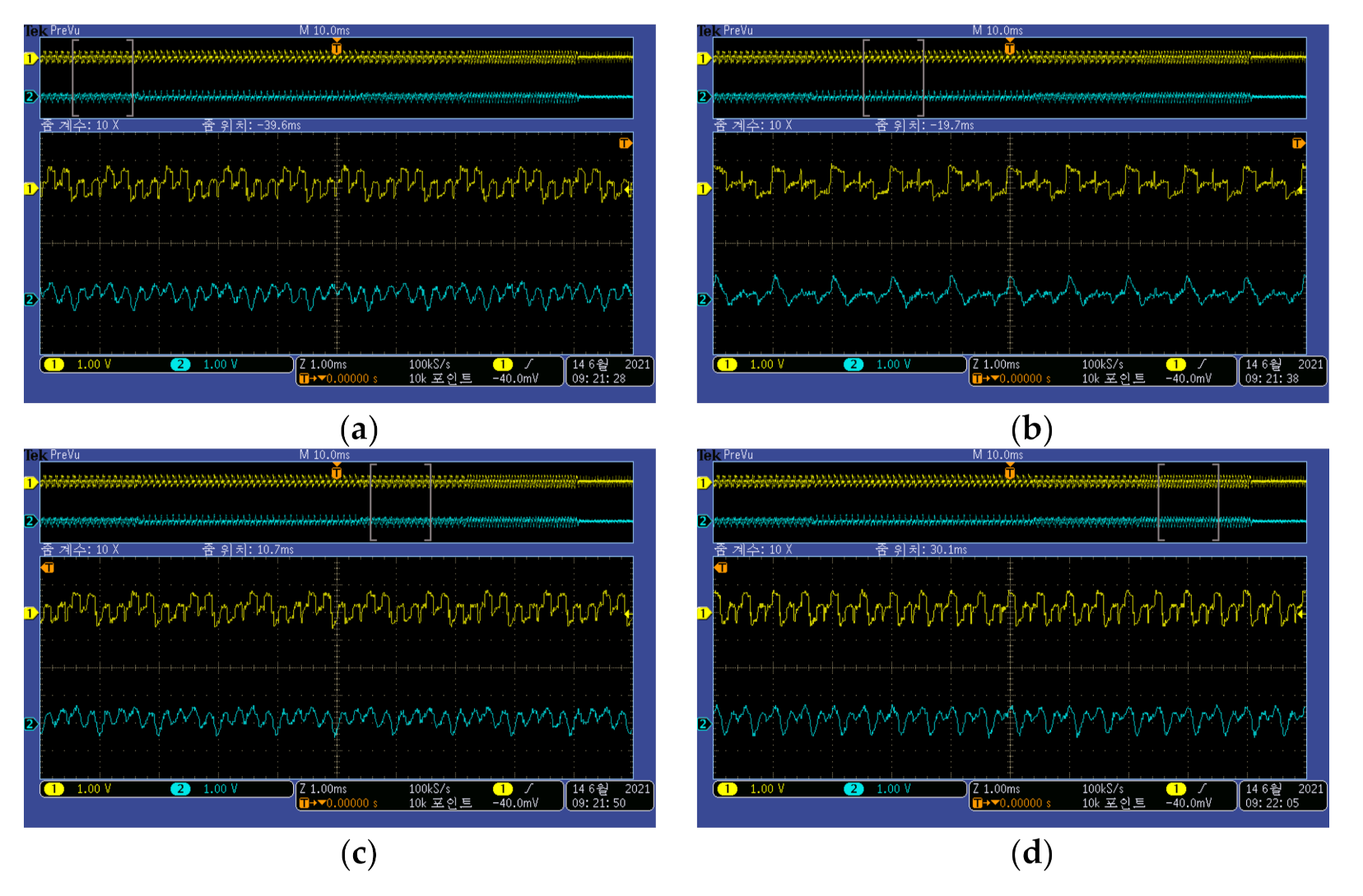


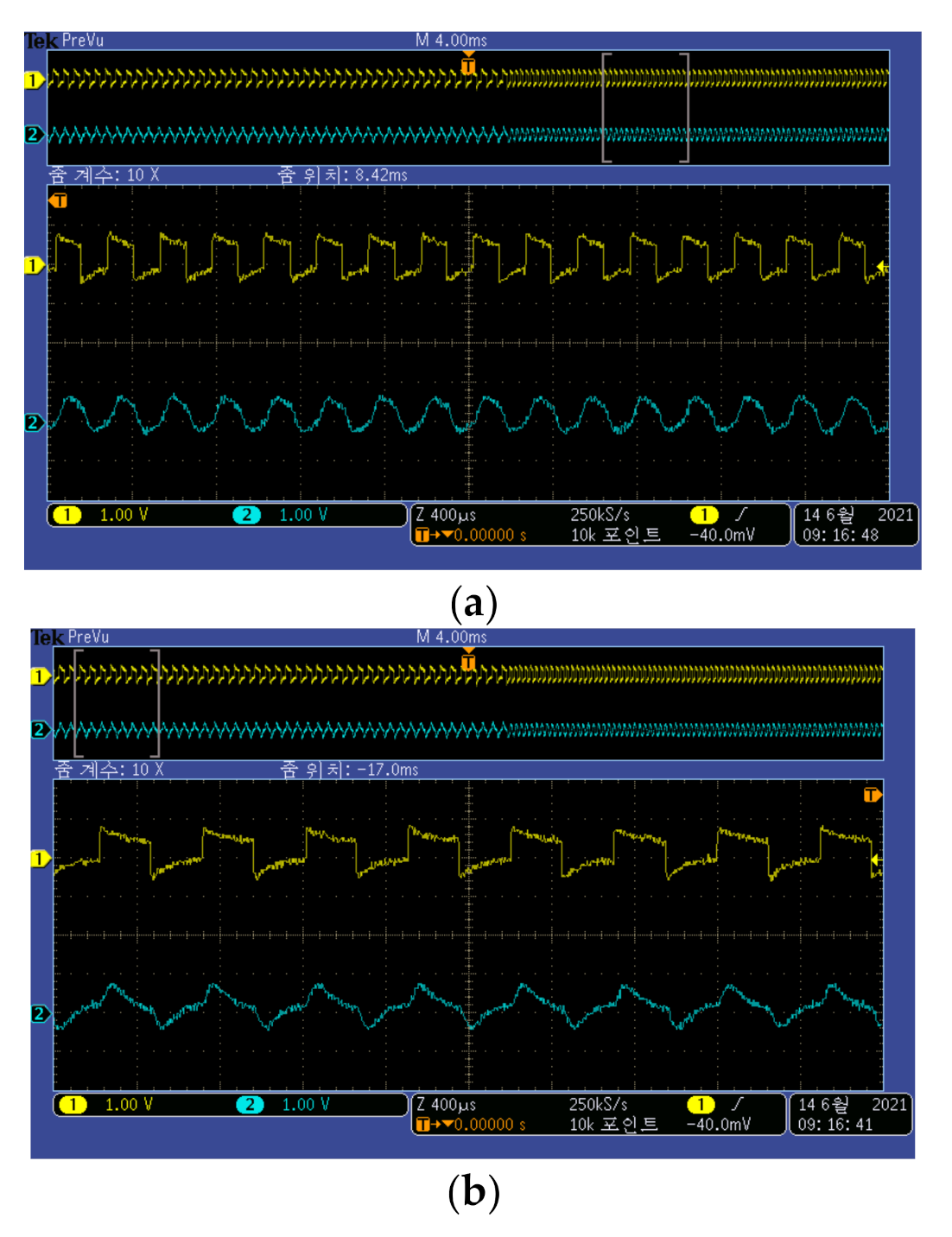
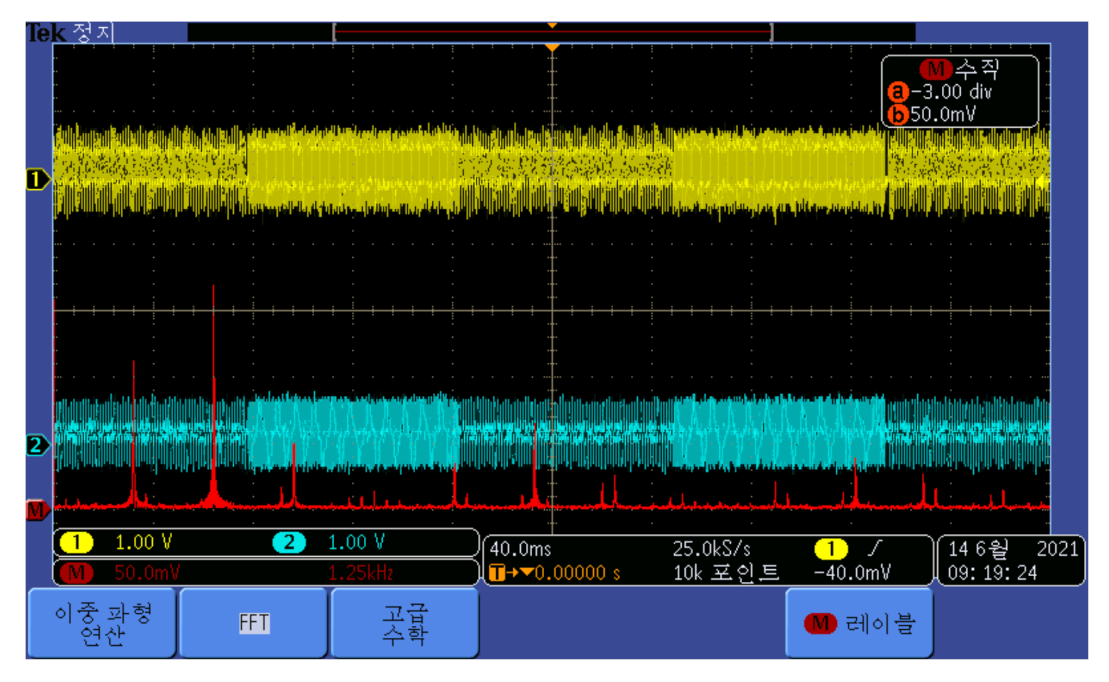
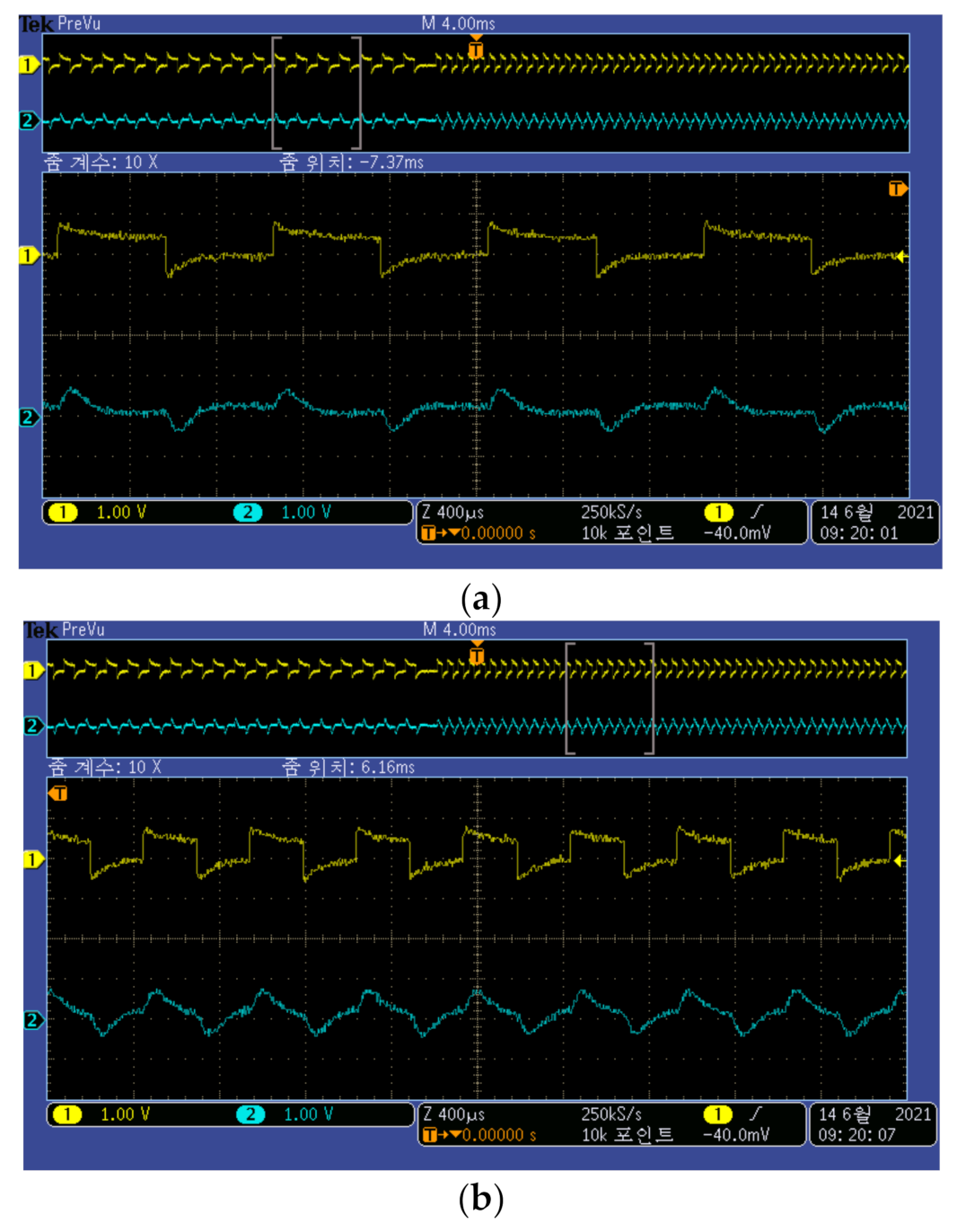

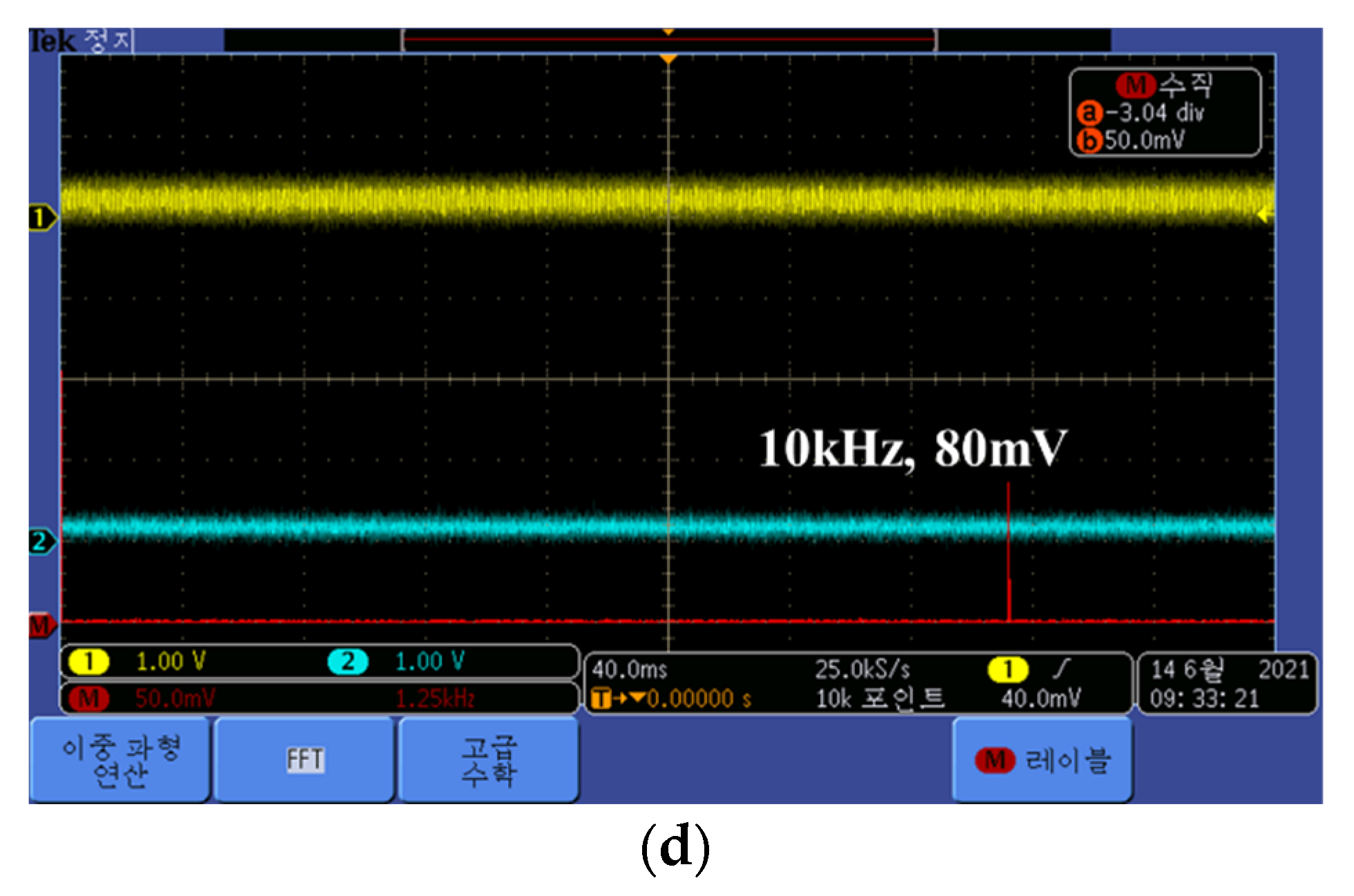
| Zone 1 | Zone 2 | Zone 3 | Zone 4 | |
|---|---|---|---|---|
| High Side | 4 kHz | 2 kHz | 4 kHz | 2 kHz |
| Low Side | 1 kHz | 1 kHz | 2 kHz | 2 kHz |
| Overlap | 4 kHz + 1 kHz | 2 kHz + 1 kHz | 4 kHz + 2 kHz | 2 kHz + 2 kHz |
| 500 (Hz) | 10 (kHz) | |
|---|---|---|
| Receiver Input(A) (V) | 1.98954 | 1.98548 |
| Receiver Output(B) (V) | 0.78144 | 0.63505 |
| Damping Ratio (%) = ((A − B)/A) × 100 | 61 (%) | 68 (%) |
| Experimental Equipment | Specification |
|---|---|
| PV Module | Model: EP30W Manufacture: EcoPower Maximum Power: 30 W Open Circuit Voltage: 21 V Optimum Operation voltage: 17.5 V Short Circuit Current: 2 A Optimum Operation Current: 1.7 A |
| Oscilloscope | Model: DPO 3034 Manufacture: Tektronix Number of Channel: 4 Ch Bandwidth: 300 MHz |
| Function Generator | Model: FG-8002 Manufacture: EZ Digital Frequency Range: 0.02 Hz~2 MHz |
| DC Power Supply | Model: GPC-3060D Manufacture: GWINSTEK Rated Power: 375 W Maximum Voltage: 30 V Maximum Current: 6 A |
| 500 (Hz) | 10 (kHz) | |
|---|---|---|
| Receiver Input(A) (V) | 200 | 175 |
| Receiver Output(B) (V) | 75 | 80 |
| Damping Ratio (%) = ((A − B)/A) × 100 | 62.5 (%) | 54.3 (%) |
Publisher’s Note: MDPI stays neutral with regard to jurisdictional claims in published maps and institutional affiliations. |
© 2021 by the authors. Licensee MDPI, Basel, Switzerland. This article is an open access article distributed under the terms and conditions of the Creative Commons Attribution (CC BY) license (https://creativecommons.org/licenses/by/4.0/).
Share and Cite
Ko, J.-S.; Kim, D.-K. Localization of Disconnection Faults in PV Installations Using the Multiple Frequencies Injection Method. Energies 2021, 14, 7346. https://doi.org/10.3390/en14217346
Ko J-S, Kim D-K. Localization of Disconnection Faults in PV Installations Using the Multiple Frequencies Injection Method. Energies. 2021; 14(21):7346. https://doi.org/10.3390/en14217346
Chicago/Turabian StyleKo, Jae-Sub, and Dae-Kyong Kim. 2021. "Localization of Disconnection Faults in PV Installations Using the Multiple Frequencies Injection Method" Energies 14, no. 21: 7346. https://doi.org/10.3390/en14217346
APA StyleKo, J.-S., & Kim, D.-K. (2021). Localization of Disconnection Faults in PV Installations Using the Multiple Frequencies Injection Method. Energies, 14(21), 7346. https://doi.org/10.3390/en14217346






